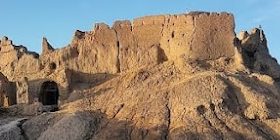Shahr-e Sukhteh: The Burnt City of Ancient Persia
Shahr-e Sukhteh, also known as the Burnt City, is one of Iran’s most significant archaeological sites, holding a history that dates back over 5,000 years. Located 50 kilometers from Zabol in the southeastern province of Sistan and Baluchestan, this ancient city is recognized as a UNESCO World Heritage Site, highlighting its immense historical and cultural value. Due to its rich discoveries, archaeologists often refer to it as the City of Knowledge and the City of Art.
The Mystery Behind Its Name
The name Shahr-e Sukhteh (which translates to “Burnt City”) has been a subject of debate among historians and archaeologists. Some theories suggest that the city was destroyed multiple times by devastating fires, as indicated by the layers of ash and burnt soil found throughout the site. However, the exact reasons for these fires remain unknown. Whether these fires were caused by natural disasters, warfare, or accidents is still an unsolved mystery.
A Cradle of Advanced Civilization
Shahr-e Sukhteh was an advanced urban settlement during its time, with evidence of skilled craftsmanship, trade, and scientific knowledge. The city had a complex drainage system, multi-room houses, and well-organized urban planning, suggesting a highly developed society. Studies indicate that it was a major cultural and economic hub in the region, with extensive trade connections to Mesopotamia, the Indus Valley, and Central Asia.
Among the most fascinating discoveries in the city are:
- Pottery and Ceramic Artifacts – Intricately designed pots and bowls displaying early artistic expression.
- Metal Tools and Handmade Objects – Advanced tools, suggesting skilled metallurgy.
- Ancient Seals – Used for administrative and commercial purposes, showing a structured economy.
- Skeletal Remains – Providing insight into the health, diet, and burial traditions of the city’s inhabitants.
The World’s Oldest Artificial Eye
One of the most extraordinary finds in Shahr-e Sukhteh was a 2,800-year-old burial site containing the remains of a young woman. What made this discovery remarkable was that she was buried with an artificial eye, made from a combination of natural tar and animal fat. This prosthetic eye, featuring delicate capillary lines to imitate blood vessels, is considered one of the oldest known examples of ocular surgery in human history.
This groundbreaking discovery indicates that the people of Shahr-e Sukhteh possessed a high level of medical knowledge, including early forms of surgical procedures and prosthetic devices.
Why Visit Shahr-e Sukhteh?
For history enthusiasts, Shahr-e Sukhteh is a must-visit destination, offering a first-hand look into one of the world’s oldest civilizations. The site continues to attract archaeologists and researchers from around the world, making it a living museum of human history.
Location & Accessibility
📍 Location: Sistan and Baluchestan Province, 65 kilometers from Zabol, Iran.
🚗 How to Get There: The site is accessible by road from Zabol and Zahedan, with guided tours available for visitors interested in exploring its fascinating ruins.
Whether you are an archaeology lover, a history enthusiast, or simply curious about the mysteries of the past, a visit to Shahr-e Sukhteh is a journey back in time to an era of remarkable human innovation and civilization.


